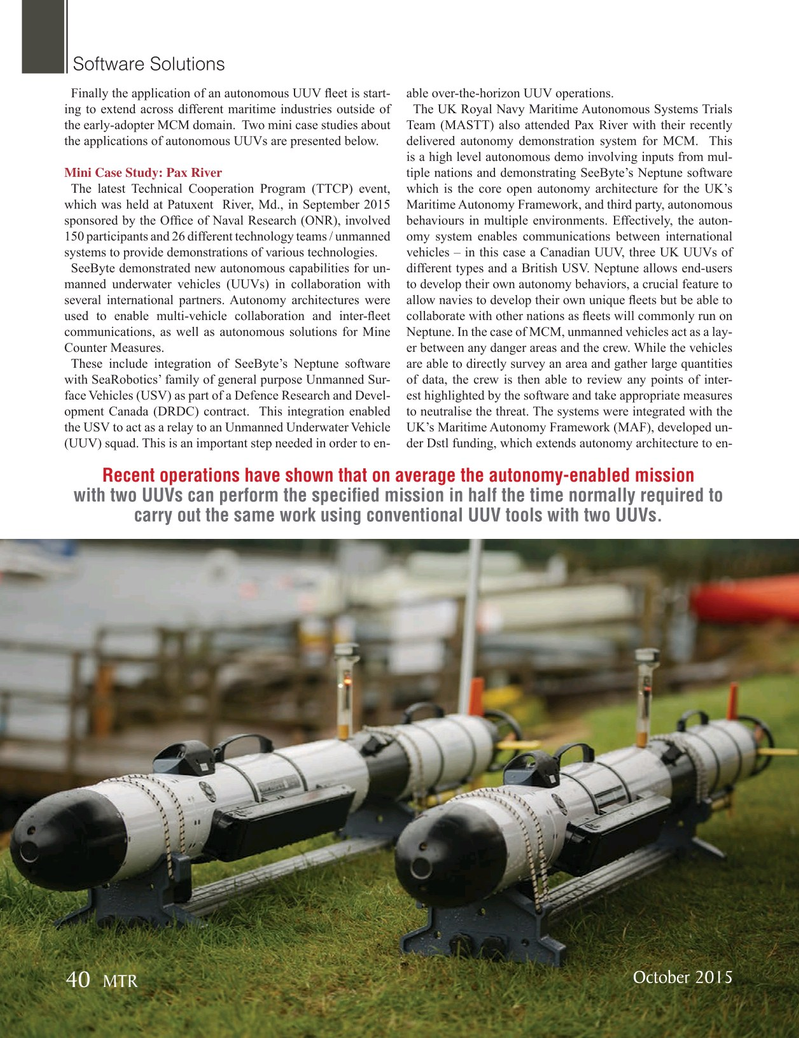
Page 40: of Marine Technology Magazine (October 2015)
AUV Operations
Read this page in Pdf, Flash or Html5 edition of October 2015 Marine Technology Magazine
Software Solutions
Finally the application of an autonomous UUV ? eet is start- able over-the-horizon UUV operations.
ing to extend across different maritime industries outside of The UK Royal Navy Maritime Autonomous Systems Trials the early-adopter MCM domain. Two mini case studies about Team (MASTT) also attended Pax River with their recently the applications of autonomous UUVs are presented below. delivered autonomy demonstration system for MCM. This is a high level autonomous demo involving inputs from mul-
Mini Case Study: Pax River tiple nations and demonstrating SeeByte’s Neptune software
The latest Technical Cooperation Program (TTCP) event, which is the core open autonomy architecture for the UK’s which was held at Patuxent River, Md., in September 2015 Maritime Autonomy Framework, and third party, autonomous sponsored by the Of? ce of Naval Research (ONR), involved behaviours in multiple environments. Effectively, the auton- 150 participants and 26 different technology teams / unmanned omy system enables communications between international systems to provide demonstrations of various technologies. vehicles – in this case a Canadian UUV, three UK UUVs of
SeeByte demonstrated new autonomous capabilities for un- different types and a British USV. Neptune allows end-users manned underwater vehicles (UUVs) in collaboration with to develop their own autonomy behaviors, a crucial feature to several international partners. Autonomy architectures were allow navies to develop their own unique ? eets but be able to used to enable multi-vehicle collaboration and inter-? eet collaborate with other nations as ? eets will commonly run on communications, as well as autonomous solutions for Mine Neptune. In the case of MCM, unmanned vehicles act as a lay-
Counter Measures. er between any danger areas and the crew. While the vehicles
These include integration of SeeByte’s Neptune software are able to directly survey an area and gather large quantities with SeaRobotics’ family of general purpose Unmanned Sur- of data, the crew is then able to review any points of inter- face Vehicles (USV) as part of a Defence Research and Devel- est highlighted by the software and take appropriate measures opment Canada (DRDC) contract. This integration enabled to neutralise the threat. The systems were integrated with the the USV to act as a relay to an Unmanned Underwater Vehicle UK’s Maritime Autonomy Framework (MAF), developed un- (UUV) squad. This is an important step needed in order to en- der Dstl funding, which extends autonomy architecture to en-
Recent operations have shown that on average the autonomy-enabled mission with two UUVs can perform the speci? ed mission in half the time normally required to carry out the same work using conventional UUV tools with two UUVs.
October 2015
MTR 40
MTR #8 (34-49).indd 40 9/30/2015 9:26:54 AM

 39
39

 41
41
